Attendance system and time records
Record working hours. Keep track of attendance to make important decisions and increase the productivity of your people.
- 14 days free
- No credit card required




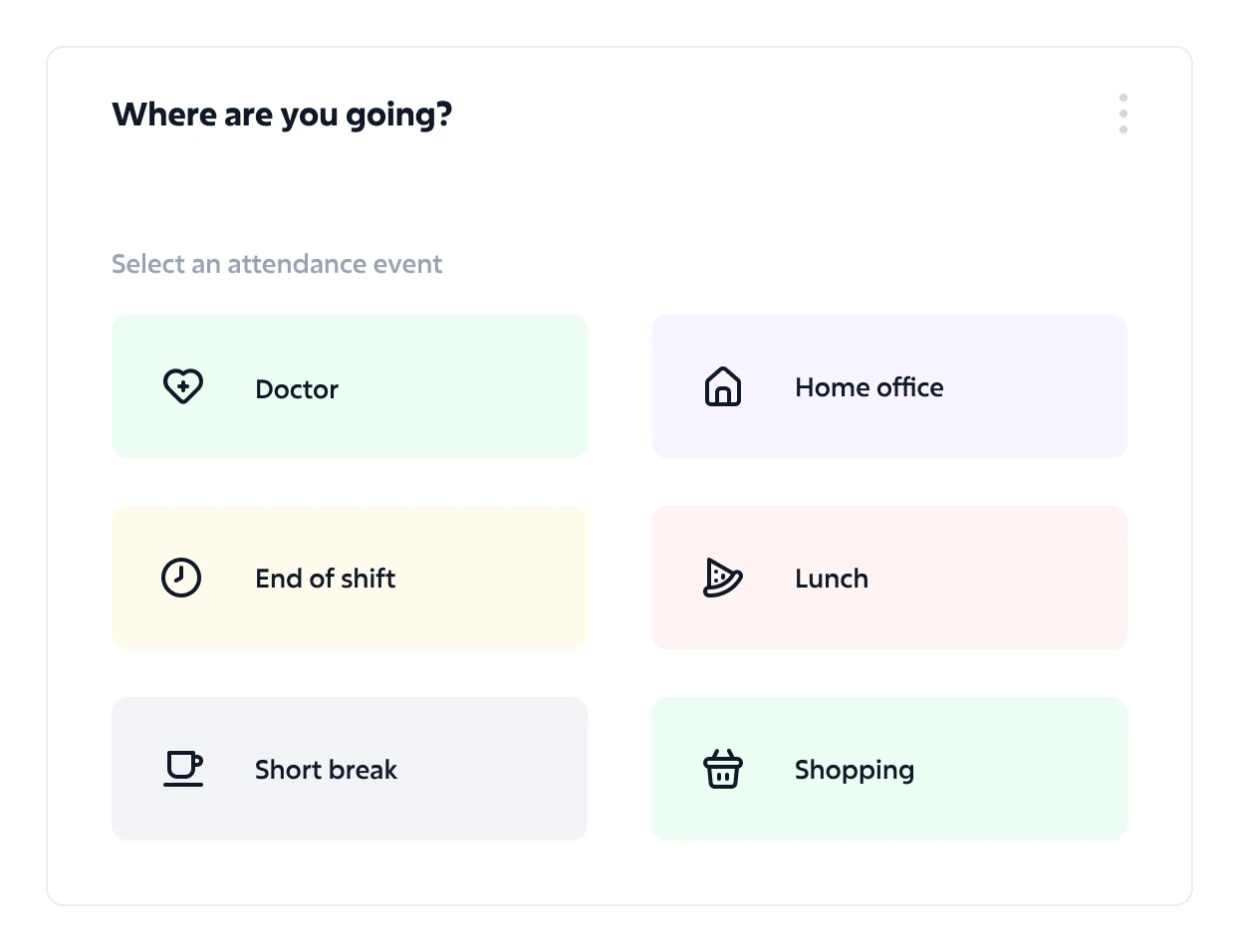
Entering work attendance
Employees simply enter their arrivals and departures via a modern interface in a mobile app, attendance terminal or web browser.
-
View arrivals and departures in the calendar
-
Any number of monitored sites
-
One or more terminals per location
-
GPS Geolocation
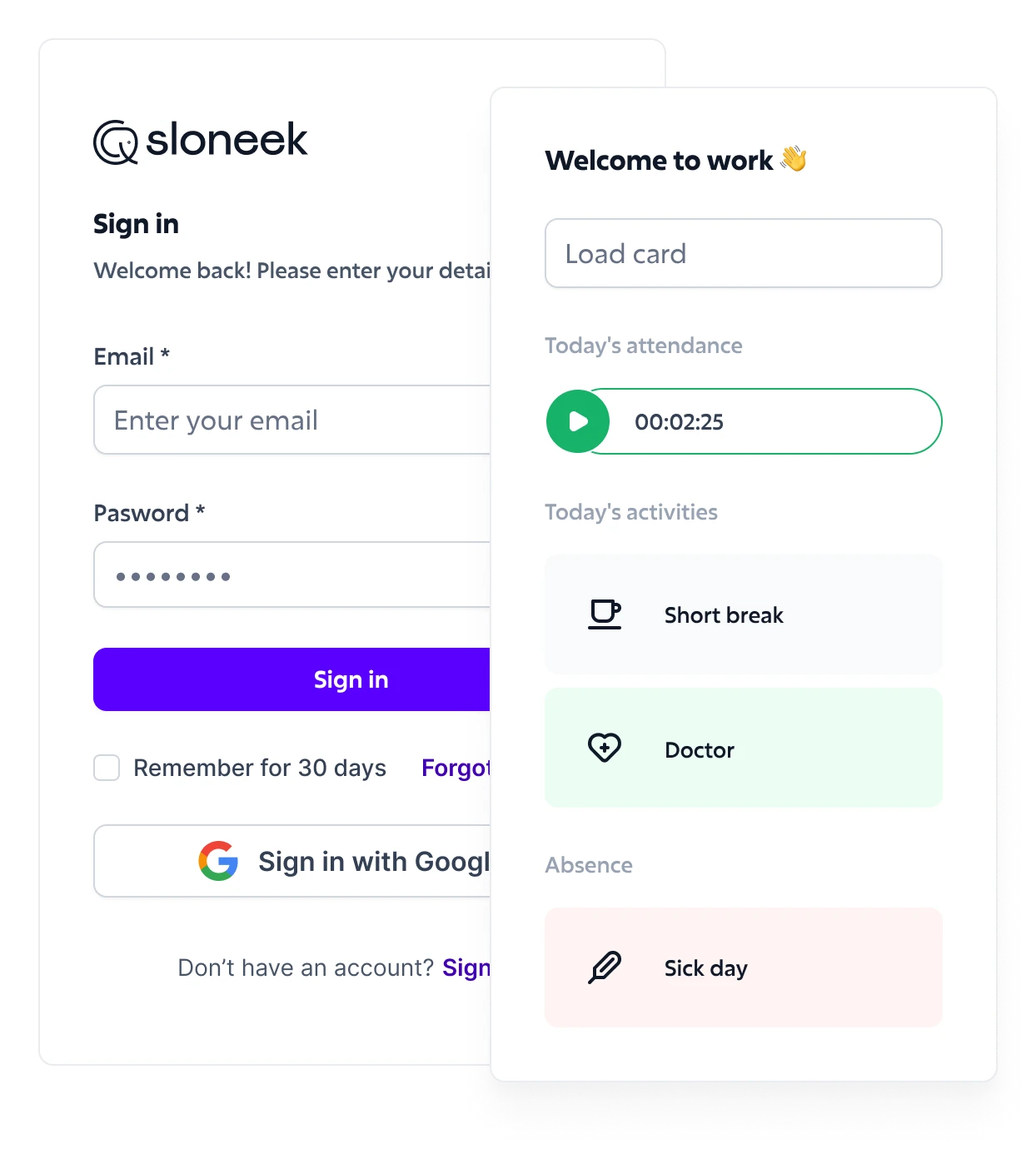
Attendance terminal
With the attendance terminal, you simply record the arrivals and departures of employees physically, at the workplace, including GPS geolocation.
-
Face scanning upon arrival and departure
-
Smart touchscreen devices
-
Option to connect a card and chip reader
-
Ability to upload user's pictures
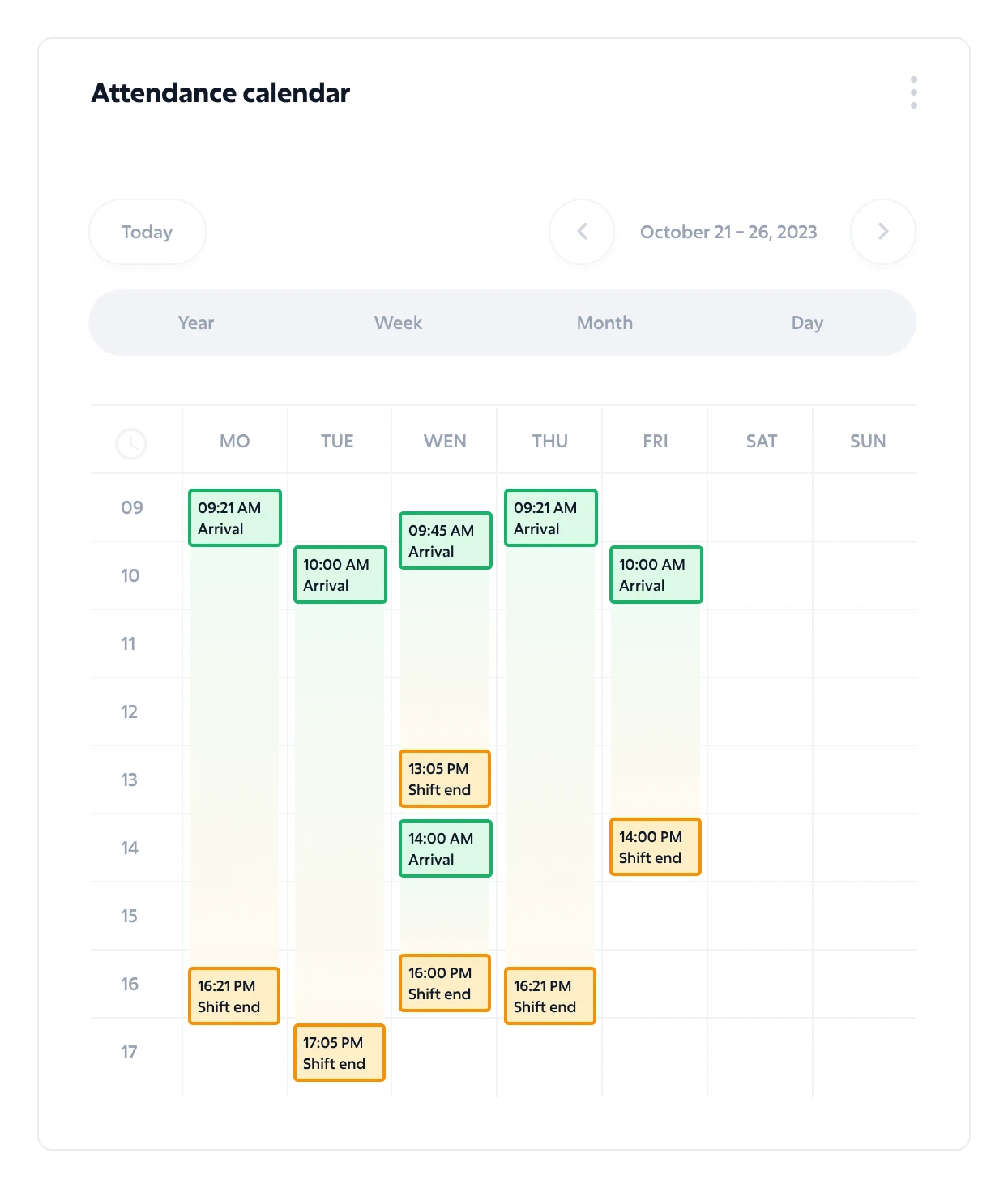
Attendance Calendar
Each check-in and check-out has its own record where users can communicate the event with their supervisor.
-
The manager sees the attendance of his colleagues
-
Chat window for each event
-
You can notify any user in a chat
-
It is possible to attach the images to the event
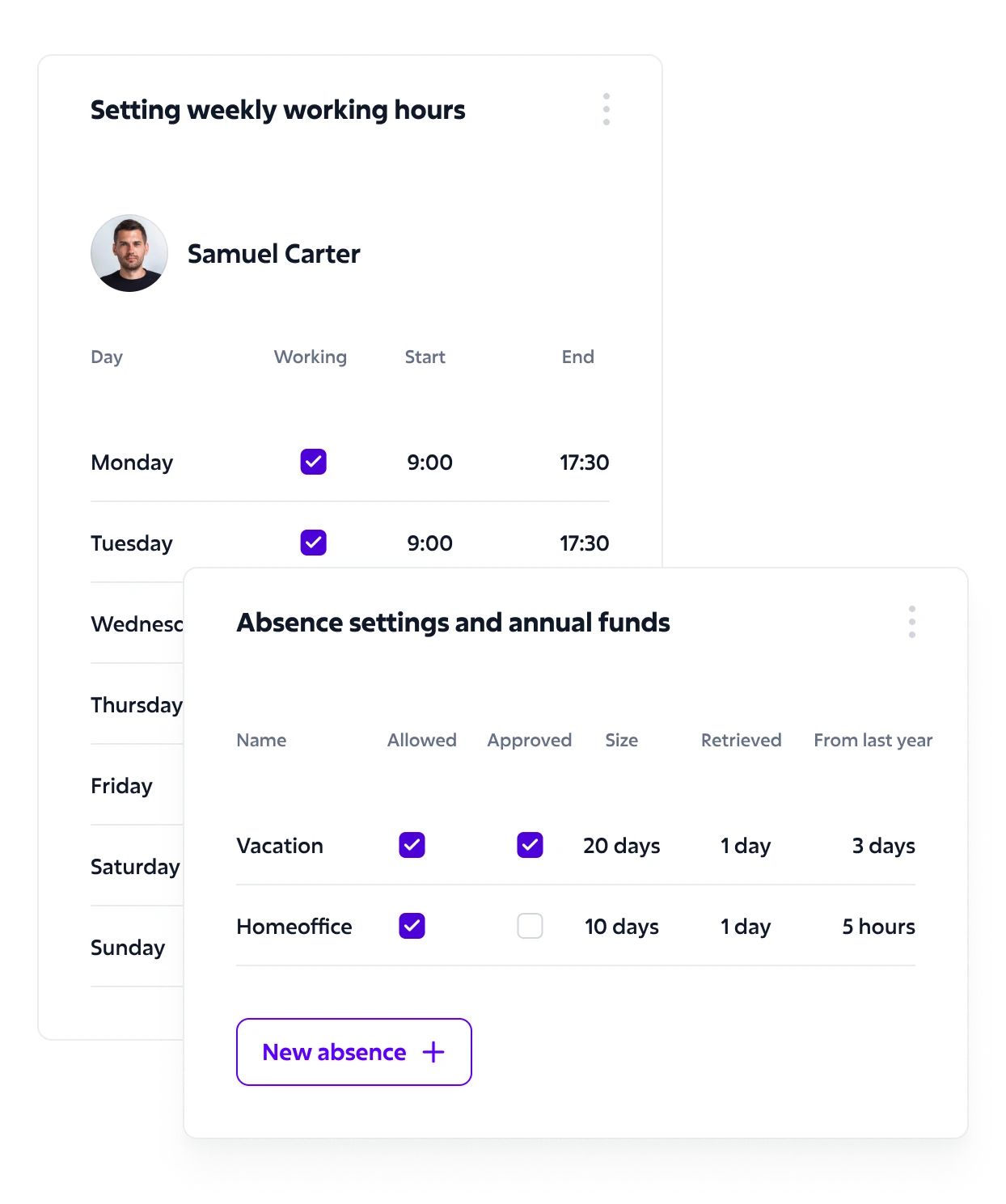
Working hours
Keep a record of contracted hours for your employees.
Get an overview of when your people work and what their monthly work pool is.
-
Creation of different working hours
-
Weekly & annual working fund
-
Automated lunch breaks
-
Comments on the validity of the contract
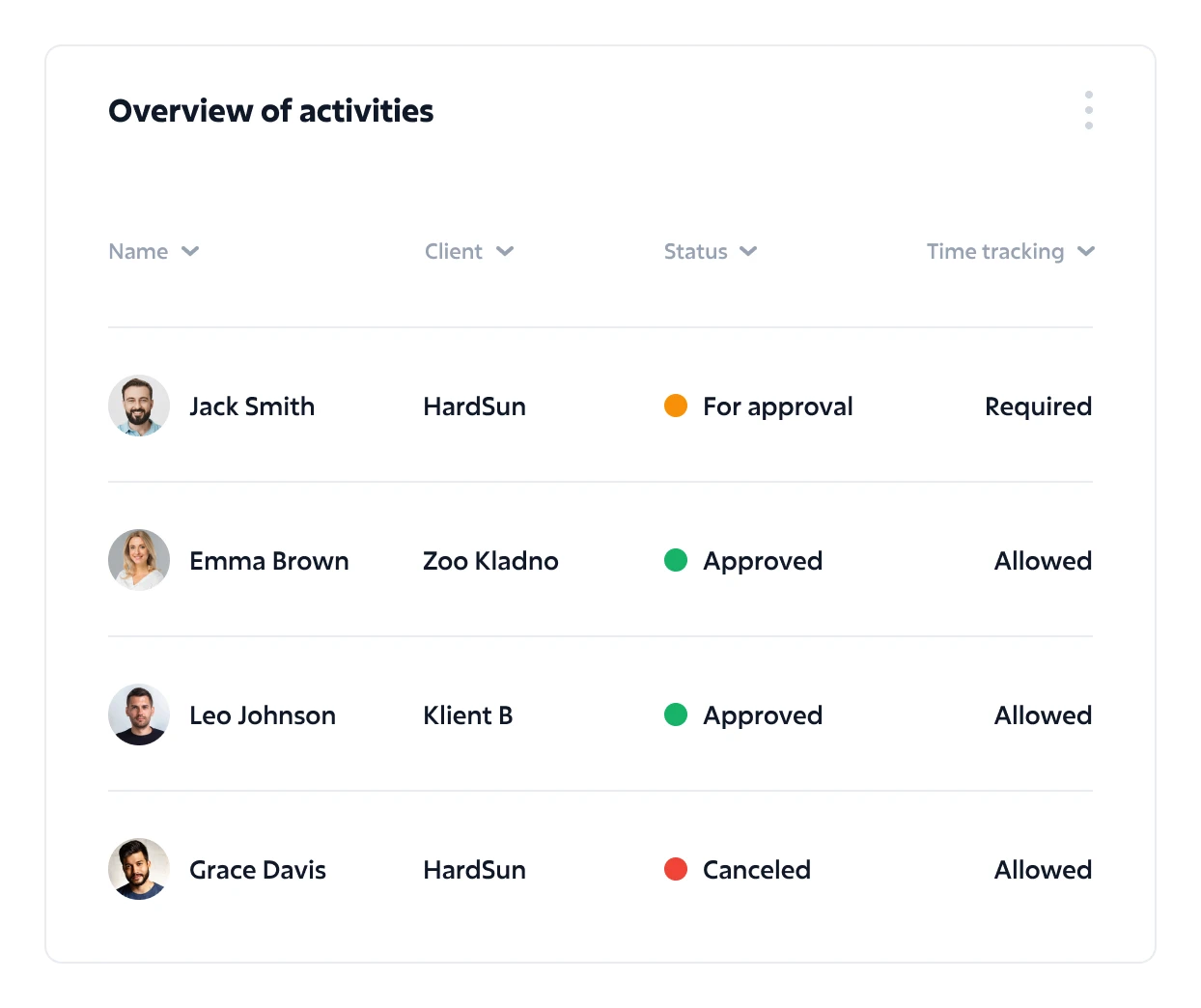
Supporting documents for payroll
All activities are entered into reports for cost and billing summary. Employees can also be matched against their monthly time pool.
-
Detailed list of registered activities
-
Summary of work for the period
-
Monthly calendar of working time
-
Comparison with working time fund
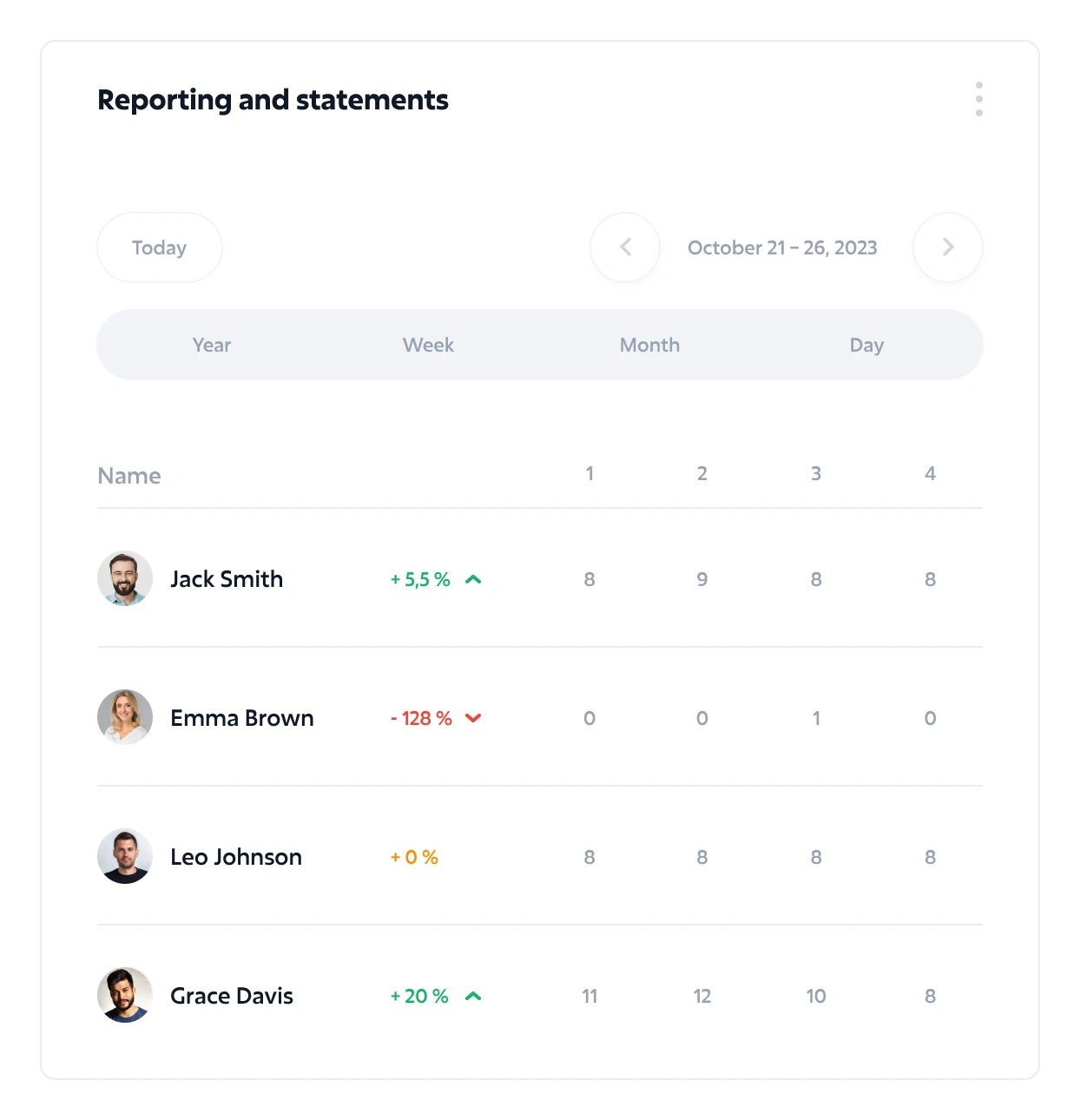
Reporting and statements
Reporting attendance is easy, but if needed, very complex reports can be created and stored for future use.
-
Overview of arrivals and departures
-
Monthly attendance calendar
-
Fully modifiable reports
-
Contingency tables and charts
-
Export reports to excel
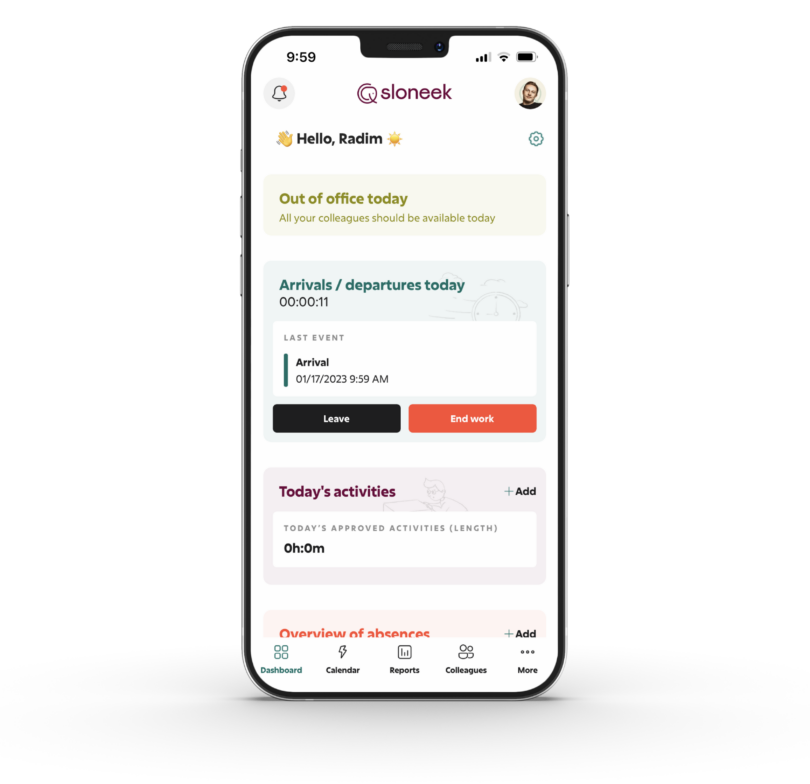
Mobile attendance
Enter attendance without physical terminal - simply by using the mobile app with GPS geolocation.
-
Arrivals and departures
One-click attendance entry.
-
Pairing with sites
Attendance is tied to company locations.
-
Communication
Communication superior, subordinate, and admin.
-
Attendance reports
They all know exactly how much time they've worked.
We are here for you
Can we help you?
Our experts will answer questions, show you Sloneek, and help modernize your HR.
- Superior onboarding
- Introduction of all functionalities
- Presentation and offer tailored to your HR
- Answer any questions




Leave us your contact details, we will get back to you.
Introduction to Attendance Tracking Systems
What is an Attendance Tracking System?
An attendance tracking system is a digital tool that allows businesses to record and manage employee attendance. It automates the process of tracking work hours, absences, and leaves, making it easier to calculate payroll, monitor employee schedules, and ensure compliance with labor regulations. Attendance tracking systems can be implemented through various methods, including paper-based systems, time clocks, spreadsheets, or dedicated time and attendance software.
Why Do You Need an Attendance Tracking System?
Attendance tracking systems offer numerous benefits for businesses of all sizes. By accurately recording employee work hours and absences, these systems provide valuable data for calculating wages, managing leave entitlements, and monitoring employee punctuality. They streamline the payroll process, reduce errors, and improve workforce management efficiency. Moreover, attendance tracking systems promote transparency, accountability, and fairness in the workplace, fostering a positive work environment.
Key Features of Attendance Tracking Systems
Attendance tracking systems come equipped with a range of features designed to streamline attendance management. These features facilitate timekeeping, absence management, employee scheduling, and more. Let’s explore some of the key features that make attendance tracking systems essential for efficient workforce management.
Timekeeping
Accurate timekeeping is a fundamental feature of attendance tracking systems. These systems enable employees to clock in and out, either through a mobile app, web portal, or physical time clock. By recording precise work hours, attendance tracking systems ensure accurate payroll processing and eliminate manual calculations.
Absence Management
Managing employee absences can be a challenging task. Attendance tracking systems simplify this process by allowing employees to request time off, and managers can review and approve these requests. These systems also provide visibility into employees’ remaining leave balances, making it easier to plan and manage workforce scheduling.
Employee Scheduling
Efficient employee scheduling is crucial for businesses with varying shifts and work hours. Attendance tracking systems offer features for creating and managing employee schedules, ensuring optimal coverage and minimizing scheduling conflicts. By automating the scheduling process, these systems save time and improve overall workforce productivity.
Employee Self-Service
Employee self-service is a valuable feature that empowers employees to manage their own attendance-related tasks. Through a user-friendly portal or mobile app, employees can view their work schedules, request time off, and track their attendance records. This self-service functionality reduces administrative burden and promotes employee engagement.
Clock-In & Clock-Out Notifications
Attendance tracking systems can send automated notifications to remind employees to clock in or out at designated times. These notifications can be delivered through email, SMS, or in-app alerts, ensuring employees stay accountable and punctual. Managers can also receive notifications when employees fail to clock in or out, allowing for prompt intervention.
GPS Tracking + Geofencing (optional)
For businesses with remote or mobile employees, attendance tracking systems may offer GPS tracking and geofencing capabilities. GPS tracking enables employers to monitor the location of employees during work hours, ensuring they are where they are supposed to be. Geofencing restricts clock-ins and clock-outs to specified locations, preventing employees from logging attendance from unauthorized areas.
Biometric Tracking (optional)
Some attendance tracking systems support biometric tracking, which uses unique physical characteristics such as fingerprints or facial recognition for clocking in and out. Biometric authentication eliminates the risk of time theft and buddy punching, ensuring accurate attendance data.
3. The Different Ways to Track Employee Time
Businesses can choose from various methods to track employee time, depending on their needs and resources. Let’s explore the different approaches to attendance tracking, ranging from traditional paper-based systems to modern time and attendance software.
Paper-based Systems
Paper-based systems involve manually recording employee work hours on timesheets or attendance registers. This method requires employees to write down their clock-in and clock-out times, which are then entered into a payroll system for wage calculation. While paper-based systems are simple and low-cost, they are prone to errors, difficult to manage, and time-consuming for payroll processing.
Time Clocks
Time clocks are physical devices that employees use to punch in and out of work. These devices can be traditional punch clocks or modern biometric time clocks that use fingerprint or facial recognition for identification. Time clocks provide a convenient and accurate way to track employee attendance, reducing the risk of time theft and fraud. However, they require upfront investment and ongoing maintenance.
Spreadsheets
Spreadsheets offer a digital alternative to paper-based systems, allowing businesses to create customized timekeeping templates. Employees enter their clock-in and clock-out times into the spreadsheet, which can be configured with formulas for automatic wage calculations. While spreadsheets provide more flexibility and accuracy than paper-based systems, they still require manual data entry and can be prone to errors.
Time and Attendance Software
Time and attendance software is a comprehensive solution for tracking employee time and managing attendance data. These software systems offer a range of features, including time clock integration, absence management, employee self-service portals, reporting and analytics tools, and seamless integration with payroll systems. Time and attendance software eliminates manual data entry, streamlines payroll processing, and provides real-time visibility into employee attendance records.
4. Benefits of Attendance Tracking Systems
Attendance tracking systems offer numerous benefits for businesses across industries. Let’s explore the key advantages of implementing an attendance tracking system in your organization.
Accurate Payroll Processing
One of the primary benefits of attendance tracking systems is their ability to ensure accurate payroll processing. These systems automate the calculation of employee wages based on recorded work hours, overtime, and leave taken. By eliminating manual calculations, attendance tracking systems reduce the risk of errors and ensure employees are paid correctly and promptly.
Overtime Calculation
For businesses with hourly employees, tracking and calculating overtime can be a complex task. Attendance tracking systems simplify this process by automatically identifying and calculating overtime hours based on predefined rules. This feature ensures compliance with labor regulations and helps businesses manage labor costs effectively.
Punctuality Monitoring
Attendance tracking systems enable businesses to monitor employee punctuality and identify attendance patterns. By recording clock-in and clock-out times, these systems provide visibility into employees’ adherence to work schedules. Managers can easily identify employees who consistently arrive late or leave early, enabling them to take appropriate actions to address attendance issues.
Leave Management
Managing employee leave can be challenging, especially in organizations with a large workforce. Attendance tracking systems streamline leave management by providing a centralized platform for employees to request time off and for managers to review and approve these requests. These systems also facilitate tracking and monitoring of employees’ remaining leave balances, ensuring compliance with company policies.
5. Factors to Consider When Choosing an Attendance Tracking System
With the wide variety of attendance tracking systems available, selecting the right system for your business can be a daunting task. Here are some key factors to consider when evaluating different attendance tracking systems:
Usability and User Interface
A user-friendly interface is crucial for ensuring that employees and managers can easily navigate the attendance tracking system. Look for systems with intuitive interfaces, well-organized menus, and clear navigation paths. A system that is easy to use and understand will minimize training time and maximize user adoption.
Mobile Accessibility
In today’s mobile workforce, it is essential for attendance tracking systems to offer mobile accessibility. Look for systems that provide mobile apps or mobile-friendly interfaces, allowing employees to clock in and out, request time off, and access attendance records from their smartphones or tablets. Mobile accessibility enhances convenience and flexibility, especially for remote or field-based employees.
Software Configuration
Consider whether you need a standalone attendance tracking system or a comprehensive HR management system that includes attendance tracking features. Determine the specific attendance management functionalities your business requires, such as time clock integration, leave management, or scheduling capabilities. Evaluate the system’s configurability to ensure it can be tailored to your organization’s unique needs.
Software Integrations
To ensure seamless data flow and eliminate duplicate data entry, choose an attendance tracking system that integrates with your payroll software, HR management system, or other relevant business systems. Integration capabilities enable automatic data synchronization, simplifying the payroll process and reducing the risk of errors.
Value for Cost
Evaluate the cost-effectiveness of different attendance tracking systems based on your budget and the features offered. Consider whether the system offers a free trial or freemium version, allowing you to test its functionality before committing to a paid plan. Take into account the long-term benefits and potential return on investment that a robust attendance tracking system can provide.
Implementation and Best Practices for Attendance Tracking Systems
Implementing an attendance tracking system requires careful planning and consideration. Here are some best practices to ensure a successful implementation:
Setting Up Your System
Before implementing an attendance tracking system, clearly define your business requirements and goals. Determine the specific features and functionalities you need, such as time clock integration, leave management, or reporting capabilities. Configure the system to align with your organization’s attendance policies and workflows. Train your HR and management teams on how to use the system effectively.
Training Employees
Provide comprehensive training to employees on how to use the attendance tracking system. Offer clear instructions on how to clock in and out, request time off, and access attendance records. Conduct training sessions or provide instructional materials that outline the system’s features and benefits. Encourage employees to ask questions and provide ongoing support as needed.
Establishing Policies and Procedures
Develop clear attendance policies and procedures that align with your organization’s goals and values. Communicate these policies to employees and ensure they understand the expectations for attendance tracking. Establish guidelines for requesting time off, reporting absences, and handling attendance issues. Regularly review and update policies as needed to ensure they remain effective and relevant.
Regular Evaluation and Optimization
Continuously monitor and evaluate the effectiveness of your attendance tracking system. Collect feedback from employees and managers to identify any issues or areas for improvement. Use the system’s reporting and analytics tools to analyze attendance data and identify trends or patterns. Make adjustments to your policies and procedures as necessary to optimize the system’s performance and address any challenges.
Security and Data Privacy Considerations
As attendance tracking systems involve handling sensitive employee data, it is essential to prioritize security and data privacy. Here are some key considerations to ensure the protection of employee information:
Protecting Employee Data
Implement robust security measures to protect employee data from unauthorized access or breaches. Use secure hosting platforms and encrypt data transmission to prevent interception. Restrict access to the attendance tracking system to authorized personnel only and enforce strong password policies. Regularly back up data and maintain disaster recovery plans to mitigate the risk of data loss.
Compliance with Data Protection Regulations
Ensure that your attendance tracking system complies with relevant data protection regulations, such as the General Data Protection Regulation (GDPR) or the California Consumer Privacy Act (CCPA). Review the system’s privacy policy and terms of service to ensure they align with your organization’s data protection obligations. Obtain necessary consent from employees before collecting and processing their personal data.
Data Encryption and Security Measures
Utilize encryption technologies to protect data stored within the attendance tracking system. Implement secure authentication mechanisms, such as two-factor authentication, to prevent unauthorized access. Regularly update and patch the system to address any security vulnerabilities. Conduct regular security audits and penetration testing to identify and mitigate potential risks.
Challenges and Pitfalls of Attendance Tracking Systems
While attendance tracking systems offer numerous benefits, there are also challenges and potential pitfalls to be aware of. Here are some common challenges businesses may face when implementing attendance tracking systems:
Employee Resistance and Privacy Concerns
Some employees may resist the implementation of attendance tracking systems, fearing invasion of privacy or increased monitoring. It is crucial to communicate the benefits of the system and address any concerns employees may have. Provide clear explanations of how their data will be used and reassure them that the system is meant to streamline processes and ensure fairness.
Technical Issues and Integration Challenges
Implementing a new system can sometimes come with technical challenges, such as compatibility issues or difficulties integrating with existing systems. Ensure proper testing and piloting of the attendance tracking system before full implementation. Work closely with the system provider to address any technical issues and ensure a smooth integration process.
Ensuring Accurate Data Entry
To ensure accurate attendance data, employees need to consistently and accurately record their clock-in and clock-out times. Encourage employees to be diligent in their time tracking and provide clear instructions on how to use the system effectively. Regularly review attendance records and address any discrepancies or issues promptly.
Future Trends in Attendance Tracking Systems
As technology continues to evolve, attendance tracking systems are likely to incorporate new features and capabilities. Here are some future trends to watch for:
Artificial Intelligence and Machine Learning
Artificial intelligence and machine learning technologies can enhance attendance tracking systems by automating processes such as leave approval, time tracking, and scheduling. These technologies can analyze attendance data to identify patterns and trends, enabling businesses to make data-driven decisions and optimize workforce management.
Advanced Biometric Technologies
Biometric technologies, such as facial recognition or iris scanning, are likely to become more prevalent in attendance tracking systems. These technologies offer enhanced security and accuracy, eliminating the risk of time theft or buddy punching.
Integration with IoT Devices
With the rise of the Internet of Things (IoT), attendance tracking systems may integrate with IoT devices to capture employee attendance data. For example, wearable devices or smart badges could automatically record employee attendance based on proximity to designated work areas.
Conclusion
Attendance tracking systems play a crucial role in streamlining workforce management and ensuring accurate payroll processing. From timekeeping and absence management to employee scheduling and self-service capabilities, these systems offer a wide range of features to meet the unique needs of businesses. By implementing an attendance tracking system, businesses can increase employee accountability, improve punctuality, simplify leave management, and enhance overall workforce efficiency.
When selecting an attendance tracking system, consider factors such as usability, mobile accessibility, software configuration, integrations, and value for cost. Evaluate the specific features and functionalities that align with your organization’s needs, and choose a system that offers a user-friendly interface and seamless integration with your existing systems.
By implementing best practices for system setup, employee training, policy establishment, and ongoing evaluation, businesses can maximize the benefits of attendance tracking systems and overcome potential challenges. Prioritize security and data privacy to protect employee information and ensure compliance with relevant regulations.
As technology advances, attendance tracking systems will continue to evolve, incorporating artificial intelligence, advanced biometric technologies, and integration with IoT devices. Stay informed about the latest trends and developments in attendance tracking systems to leverage the full potential of these tools for your organization.
By adopting an attendance tracking system that meets your business needs, you can boost efficiency, streamline workforce management, and ensure accurate payroll processing. Take the first step towards transforming your attendance management processes today.


